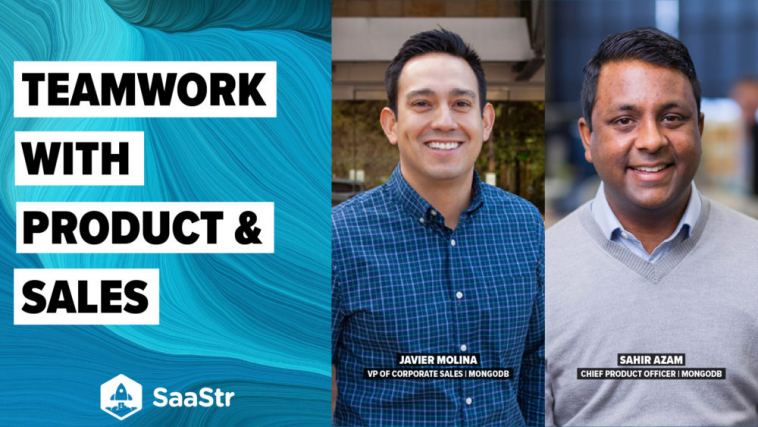- Like
- SHARE
- Digg
- Del
- Tumblr
- VKontakte
- Flattr
- Buffer
- Love This
- Save
- Odnoklassniki
- Meneame
- Blogger
- Amazon
- Yahoo Mail
- Gmail
- AOL
- Newsvine
- HackerNews
- Evernote
- MySpace
- Mail.ru
- Viadeo
- Line
- Comments
- Yummly
- SMS
- Viber
- Telegram
- JOIN
- Skype
- Facebook Messenger
- Kakao
- LiveJournal
- Yammer
- Edgar
- Fintel
- Mix
- Instapaper
- Copy Link
When you’re trying to grow your SaaS business, the challenges can stack against you. How can you optimize your market reach while pushing product innovation to carry you into the future?
In this guide, Sahir Azam, Chief Product Officer at MongoDB, and Javier Molina, SVP at MongoDB, share their journey to increasing company revenue through their cohesive sales and product relationship. When sales and product work together, amazing things happen.
Here’s how they scaled their open-source product with a bottom-up and top-down sales motion.
Seeding the Market & Early Monetization
MongoDB is open-source software (OSS) database technology released ten years ago used by developers to build modern applications. Their initial growth strategy was to drive widespread developer adoption, followed by monetization at the enterprise level. The idea was to make money from early adopters through an upsell of their proprietary technology and eventually scale to mainstream enterprise adoption.
The MongoDB OSS was useful for a broad market of developers from the beginning. However, as Azam points out, the product team built additional proprietary features and functionalities best suited for the enterprise tier. The limited revenue segment meant that the new features were all concentrated at the enterprise level without much room for SMBs or mid-market customers.
The sales team realized something further: While they were undoubtedly driving high developer adoption volume, they weren’t maximizing their revenue. Why? Because of the enterprise-only focus, most of their money came from the end of the application life cycle for Risk Mitigation and Mission Critical Apps. Based on observations from both the sales and product teams, they knew there were more opportunities to increase their revenue along the application life cycle.
Transition to SaaS
MongoDB unveiled Atlas (their cloud-native database) and pivoted to a SaaS model to accommodate a wider market and increase revenue. Since SaaS opened up its potential customer base to a much larger audience it was necessary to introduce three separate sales channels:
- Self-Service
- Inside Sales
- Enterprise Field Sales
So Why Open Up New Sales Channels?
- Reach a Massive Market: Customers have different buying behaviors and vendor expectations, and the variety of sales channels caters to these differences. Additionally, the separate channels offer a lower barrier to entry and the opportunity to reach a global audience.
- Efficiently Serve Customers: By diversifying their sales channels, they optimized CAC (Customer Acquisition Cost) to address many users and use cases. Further, the various channels helped MongoDB reach customers at all spend levels, not just enterprise.
- Increase Revenue: By opening the door to more sales channels, MongoDB opened the door to more customers and higher sales.
MongoDB responded to the market demand by offering a cloud-based platform, and their sales team opened up more opportunities for acquiring customers. And because of the transition to a SaaS model, they could monetize the entire app life cycle and sell to all apps, not just Mission Critical.
The Results
MongoDB saw extraordinary results after introducing its SaaS model and embracing the cloud. As of 2021, 47% of MongoDB’s total revenue comes from Atlas (the cloud). Their customer reach nearly tripled: in Q1 2019, there were 6,600+ customers, and in Q1 2021, there are over 18,400. In the past four years, EA + Atlas made over $500 million. EA alone in ten years made only $100 million.
After making the strategic pivot to a SaaS model, MongoDB now has three Sales Channels,130 million+ downloads, 2 million+ free accounts. These impressive results happened because sales and product worked together to build a tool that the market could embrace and reach more customers through a diversity of sales channels. If they can do it, so can you.
Key Takeaways:
- SaaS is the most powerful way to monetize open-source.
- Build a product journey that benefits both the customer and the business.
- Master all the sales motions so that they work together.
- The future of SaaS will be combining product-led growth and Enterprise-level sales processes.

![how-the-hubspot-blog-generates-leads-[+-how-yours-can,-too]](https://everythingflex.com/wp-content/uploads/2021/01/7626-how-the-hubspot-blog-generates-leads-how-yours-can-too-150x150.jpg-23keepprotocol)
